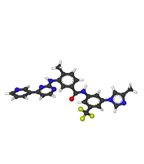Nilotinib for CML Leads to Fewer Treatment-Emergent Mutations Than Imatinib
CML patients treated with nilotinib had fewer treatment-emergent BCR-ABL mutations than those treated with imatinib, and among patients who did have a mutation, those treated with nilotinib had reduced rates of progression to accelerated phase and blast phase of the disease.
Chronic myeloid leukemia (CML) patients treated with nilotinib had fewer treatment-emergent BCR-ABL mutations than those treated with imatinib, and among patients who did have a mutation, those treated with nilotinib had reduced rates of progression to accelerated phase and blast phase of the disease, according to results from the phase III ENESTnd trial.

Ball-and-stick model of nilotinib
“Mutations in the kinase domain of BCR-ABL are a common mechanism of resistance to TKI therapy, and these mutations have been detected in 40% to 60% of imatinib-resistant patients,” wrote study authors led by Andreas Hochhaus, MD, of the University Medical Center Jena in Germany, in the journal Blood, on March 15. Researchers have previously identified more than 90 distinct mutations, and nilotinib has in vitro inhibitory activity against all but one of these.
Hochhaus and colleagues analyzed data from the ENESTnd phase III trial to look for emergent mutations during treatment; the trial previously showed better responses and lower chance of progression to accelerated or blast phase CML with nilotinib compared with imatinib.
No mutations in BCR-ABL were present at baseline. The analysis showed that at the 3-year data cutoff, 21 patients in a group who received imatinib 400 mg once daily had a mutation. In each of the two nilotinib groups (300 mg twice daily and 400 mg twice daily), there were 11 patients with mutations. Most of the mutations were nilotinib-sensitive and imatinib-resistant, and the one BCR-ABL mutation shown to be resistant to nilotinib in vitro was found in three, two, and three patients in each of the three groups.
“While most patients with emergent mutations in ENESTnd had suboptimal response or treatment failure, relatively fewer nilotinib-treated patients with emergent mutations than imatinib-treated patients with emergent mutations progressed … or lost response on treatment,” the authors wrote. In the two nilotinib groups, 1 of 11 and 2 of 11 patients progressed to accelerated or blast phase CML; 7 of the 21 imatinib patients with mutations progressed. The authors noted the similarity in rates in the nilotinib arms, suggesting the higher dose of the drug does not increase likelihood of emergent mutations.
Mutations were more likely among patients with intermediate or high Sokal score at study entry, in all treatment arms. Along with poorer responses to treatment among those with emergent mutations, the authors noted that the chance of developing mutations could be linked to a predisposition for developing resistance to treatment thanks to genomic instability.
“These results further support the use of nilotinib in patients with newly diagnosed Ph-positive CML-chronic phase,” they wrote.